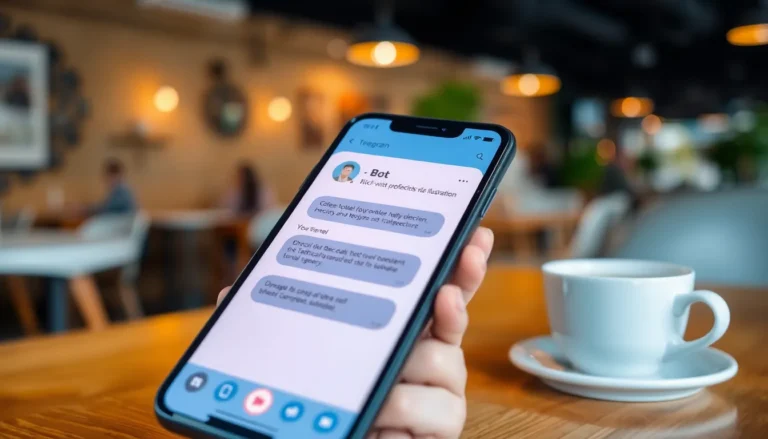Mobile technology is transforming healthcare faster than you can say “text your doctor.” With smartphones and apps now in our pockets, patients and providers are experiencing a revolution that’s making healthcare more accessible and efficient. Imagine booking an appointment without the dreaded hold music or checking your blood pressure with a tap—it’s like having a mini hospital right at your fingertips.
But it’s not just about convenience; mobile tech is saving lives. From remote monitoring to telehealth consultations, this innovation is bridging gaps in care and empowering patients like never before. So, buckle up as we dive into the fascinating world of mobile technology in healthcare, where your phone might just become your best doctor.
Table of Contents
ToggleOverview of Mobile Technology in Healthcare
Mobile technology plays a pivotal role in modern healthcare. Smartphones facilitate easy appointment scheduling and provide immediate access to medical information. Apps enable patients to monitor health metrics like blood pressure and glucose levels. Telehealth services allow for remote consultations, connecting patients with healthcare providers without needing to visit facilities.
Healthcare professionals access patient records instantly through mobile devices. This access enhances decision-making and improves patient outcomes. Data indicates that telehealth consultations increased by 154% during the COVID-19 pandemic, showing the demand for these technologies.
Security protocols protect patient information as mobile technology advances. Encryption techniques and secure access controls safeguard sensitive data. Compliance with regulations, such as HIPAA, ensures that mobile health applications maintain privacy standards.
Adoption rates of mobile health applications continue to rise. A report from the American Hospital Association found that 74% of healthcare organizations offer telehealth services. Patients appreciate the convenience of managing health through mobile devices, leading to increased engagement in their care.
Trust in mobile technology grows as users experience benefits first-hand. Enhanced communication channels allow for better interaction between patients and healthcare providers. Mobile technology in healthcare serves as a vital tool for improving overall health management in today’s fast-paced world.
Benefits of Mobile Technology in Healthcare
Mobile technology significantly improves patient outcomes and healthcare efficiency. It enhances patient engagement, communication, and access to information.
Improved Patient Engagement
Mobile technology fosters greater patient engagement. Patients monitor their health, track medications, and set reminders through apps. This proactive approach leads to improved health management. Healthcare providers utilize data from these apps to personalize treatment plans. Engaging patients promotes adherence to prescribed regimens, reducing hospital readmission rates. Apps empower individuals to take charge of their health by providing instant feedback on progress. Improved engagement increases patient satisfaction scores and strengthens the patient-provider relationship.
Enhanced Communication
Mobile technology enhances communication between patients and healthcare providers. Real-time messaging allows patients to quickly ask questions or report issues. Providers respond to inquiries efficiently, improving satisfaction and trust. Telehealth services expand communication options, enabling remote consultations. These consultations reduce delays, allowing timely care. Instant access to medical information and patient records also streamlines communication for healthcare professionals. Enhanced coordination leads to better decisions and care continuity, ultimately improving health outcomes.
Challenges and Limitations
Mobile technology in healthcare faces several notable challenges and limitations that can impact its effectiveness.
Data Security Concerns
Data security presents a significant challenge. Healthcare data breaches increased by 23% in 2022, creating risks for sensitive patient information. Mobile devices often lack robust security measures, making them vulnerable to hacking and unauthorized access. Compliance with regulations like HIPAA is essential, but not all apps meet these standards, leading to potential legal issues. Patients may struggle with trust, fearing that their personal data could be compromised. Encryption plays a crucial role in safeguarding information, yet its implementation varies across apps and devices. Continuous efforts to educate healthcare providers about cybersecurity practices are necessary to enhance data protection.
Accessibility Issues
Accessibility issues also hinder the widespread adoption of mobile technology in healthcare. Not everyone has access to smartphones or reliable internet, creating barriers for low-income populations. Rural areas often experience inadequate connectivity, limiting telehealth’s effectiveness. Additionally, older adults may struggle with using mobile technology due to lack of digital literacy. Mobile apps must cater to diverse user needs, including those with disabilities, to promote inclusivity. Language barriers may also prevent certain patients from fully utilizing mobile health tools. Addressing these concerns requires a concerted effort from developers and healthcare organizations to ensure equitable access to mobile healthcare solutions.
Future Trends in Mobile Technology
Mobile technology continues to advance, shaping the future of healthcare. Several key trends signify its potential to further enhance patient care and access.
Telemedicine Evolution
Telemedicine evolves rapidly, driven by an increasing demand for remote healthcare services. In 2022, telehealth consultations surged by 154%, showcasing its growing necessity. Patients now experience greater convenience, receiving care from their homes without travel. Healthcare providers benefit from enhanced flexibility and efficiency in managing appointments. Innovations in video communication systems improve the quality of interactions, bridging gaps between patients and doctors. As regulations adapt, insurance coverage for telehealth services expands, making it easier than ever for individuals to seek virtual care. Expect telemedicine to encompass more specialty services, ensuring comprehensive treatment options for patients.
Wearable Health Devices
Wearable health devices gain traction, empowering individuals to actively monitor their health metrics. Devices such as smartwatches and fitness trackers provide real-time data, allowing users to track heart rates, activity levels, and sleep patterns. In 2023, the market for wearables is projected to reach $70 billion, indicating significant consumer investment in health technology. Integration with mobile health applications enables users to store and analyze their data for improved health management. Healthcare providers utilize this collected data to enhance preventive care and tailor treatment plans. As technology advances, expect wearables to include even more sophisticated features, such as blood glucose monitoring and early disease detection, further enriching patient care.
Mobile technology is reshaping healthcare by enhancing accessibility and efficiency for patients and providers alike. The ability to monitor health metrics and access medical information on-the-go empowers individuals to take charge of their health. As telehealth services continue to expand and wearable devices gain popularity, the future of healthcare looks promising.
However, addressing challenges like data security and accessibility is crucial for maximizing the benefits of mobile technology. By prioritizing robust security measures and ensuring equitable access, healthcare organizations can foster trust and engagement among users. Ultimately, mobile technology stands as a vital component in improving health management and patient outcomes in an increasingly digital world.










